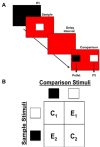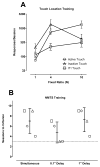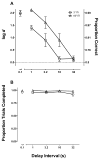Effects of environmental and pharmacological manipulations on a novel delayed nonmatching-to-sample 'working memory' procedure in unrestrained rhesus monkeys
- PMID: 26003863
- PMCID: PMC4500667
- DOI: 10.1016/j.jneumeth.2015.05.009
Effects of environmental and pharmacological manipulations on a novel delayed nonmatching-to-sample 'working memory' procedure in unrestrained rhesus monkeys
Abstract
Background: Working memory is a domain of 'executive function.' Delayed nonmatching-to-sample (DNMTS) procedures are commonly used to examine working memory in both human laboratory and preclinical studies.
New method: The aim was to develop an automated DNMTS procedure maintained by food pellets in rhesus monkeys using a touch-sensitive screen attached to the housing chamber. Specifically, the DNMTS procedure was a 2-stimulus, 2-choice recognition memory task employing unidimensional discriminative stimuli and randomized delay interval presentations.
Results: DNMTS maintained a delay-dependent decrease in discriminability that was independent of the retention interval distribution. Eliminating reinforcer availability during a single delay session or providing food pellets before the session did not systematically alter accuracy, but did reduce total choices. Increasing the intertrial interval enhanced accuracy at short delays. Acute Δ(9)-THC pretreatment produced delay interval-dependent changes in the forgetting function at doses that did not alter total choices. Acute methylphenidate pretreatment only decreased total choices.
Comparison with existing methods: All monkeys were trained to perform NMTS at the 1s training delay within 60 days of initiating operant touch training. Furthermore, forgetting functions were reliably delay interval-dependent and stable over the experimental period (∼6 months).
Conclusions: Consistent with previous studies, increasing the intertrial interval improved DNMTS performance, whereas Δ(9)-THC disrupted DNMTS performance independent of changes in total choices. Overall, the touchscreen-based DNMTS procedure described provides an efficient method for training and testing experimental manipulations on working memory in unrestrained rhesus monkeys.
Keywords: Delayed nonmatching to sample; Methylphenidate; Rhesus monkey; Touchscreen; Working memory; Δ(9)-Tetrahydrocannabinol.
Copyright © 2015 Elsevier B.V. All rights reserved.
Figures







Similar articles
-
Remifentanil maintains lower initial delayed nonmatching-to-sample accuracy compared to food pellets in male rhesus monkeys.Exp Clin Psychopharmacol. 2017 Dec;25(6):441-447. doi: 10.1037/pha0000154. Exp Clin Psychopharmacol. 2017. PMID: 29251972 Free PMC article.
-
Effects of methylphenidate on working memory in pigeons.Cogn Affect Behav Neurosci. 2003 Dec;3(4):300-8. doi: 10.3758/cabn.3.4.300. Cogn Affect Behav Neurosci. 2003. PMID: 15040550
-
A novel touch-sensitive apparatus for behavioral studies in unrestrained squirrel monkeys.J Neurosci Methods. 2012 Aug 15;209(2):331-6. doi: 10.1016/j.jneumeth.2012.06.028. Epub 2012 Jul 10. J Neurosci Methods. 2012. PMID: 22790109 Free PMC article.
-
Effects of aging on visual recognition memory in the rhesus monkey.Neurobiol Aging. 1988 Sep-Dec;9(5-6):495-502. doi: 10.1016/s0197-4580(88)80103-9. Neurobiol Aging. 1988. PMID: 3062461 Review.
-
Memory procedures, performance and processes in pigeons.Brain Res Cogn Brain Res. 1996 Jun;3(3-4):309-17. doi: 10.1016/0926-6410(96)00016-x. Brain Res Cogn Brain Res. 1996. PMID: 8806032 Review.
Cited by
-
Methocinnamox (MCAM) antagonizes the behavioral suppressant effects of morphine without impairing delayed matching-to-sample accuracy in rhesus monkeys.Psychopharmacology (Berl). 2020 Oct;237(10):3057-3065. doi: 10.1007/s00213-020-05592-y. Epub 2020 Aug 9. Psychopharmacology (Berl). 2020. PMID: 32772146 Free PMC article.
-
A Metric-Based, Meta-Analytic Appraisal of Environmental Enrichment Efficacy in Captive Primates.Animals (Basel). 2025 Mar 11;15(6):799. doi: 10.3390/ani15060799. Animals (Basel). 2025. PMID: 40150328 Free PMC article. Review.
-
A Kiosk Station for the Assessment of Multiple Cognitive Domains and Cognitive Enrichment of Monkeys.Front Behav Neurosci. 2021 Aug 26;15:721069. doi: 10.3389/fnbeh.2021.721069. eCollection 2021. Front Behav Neurosci. 2021. PMID: 34512289 Free PMC article.
-
Macaque monkeys learn and perform a non-match-to-goal task using an automated home cage training procedure.Sci Rep. 2021 Jan 29;11(1):2700. doi: 10.1038/s41598-021-82021-w. Sci Rep. 2021. PMID: 33514812 Free PMC article.
-
Touchscreen technology in the study of cognition-related behavior.Behav Pharmacol. 2017 Dec;28(8):623-629. doi: 10.1097/FBP.0000000000000356. Behav Pharmacol. 2017. PMID: 29064843 Free PMC article. Review.
References
-
- Aharonovich E, Hasin DS, Brooks AC, Liu X, Bisaga A, Nunes EV. Cognitive deficits predict low treatment retention in cocaine dependent patients. Drug and alcohol dependence. 2006;81:313–322. - PubMed
-
- Aigner TG. Delta-9-tetrahydrocannabinol impairs visual recognition memory but not discrimination learning in rhesus monkeys. Psychopharmacology. 1988;95:507–511. - PubMed
-
- Bain JN, Prendergast MA, Terry AV, Jr, Arneric SP, Smith MA, Buccafusco JJ. Enhanced attention in rhesus monkeys as a common factor for the cognitive effects of drugs with abuse potential. Psychopharmacology. 2003;169:150–160. - PubMed
-
- Berry MS, Odum AL. Reinforcer magnitude and resistance to disruption of forgetting functions and response rates. Journal of the experimental analysis of behavior. 2014;101:373–384. - PubMed
Publication types
MeSH terms
Substances
Grants and funding
LinkOut - more resources
Full Text Sources
Other Literature Sources

